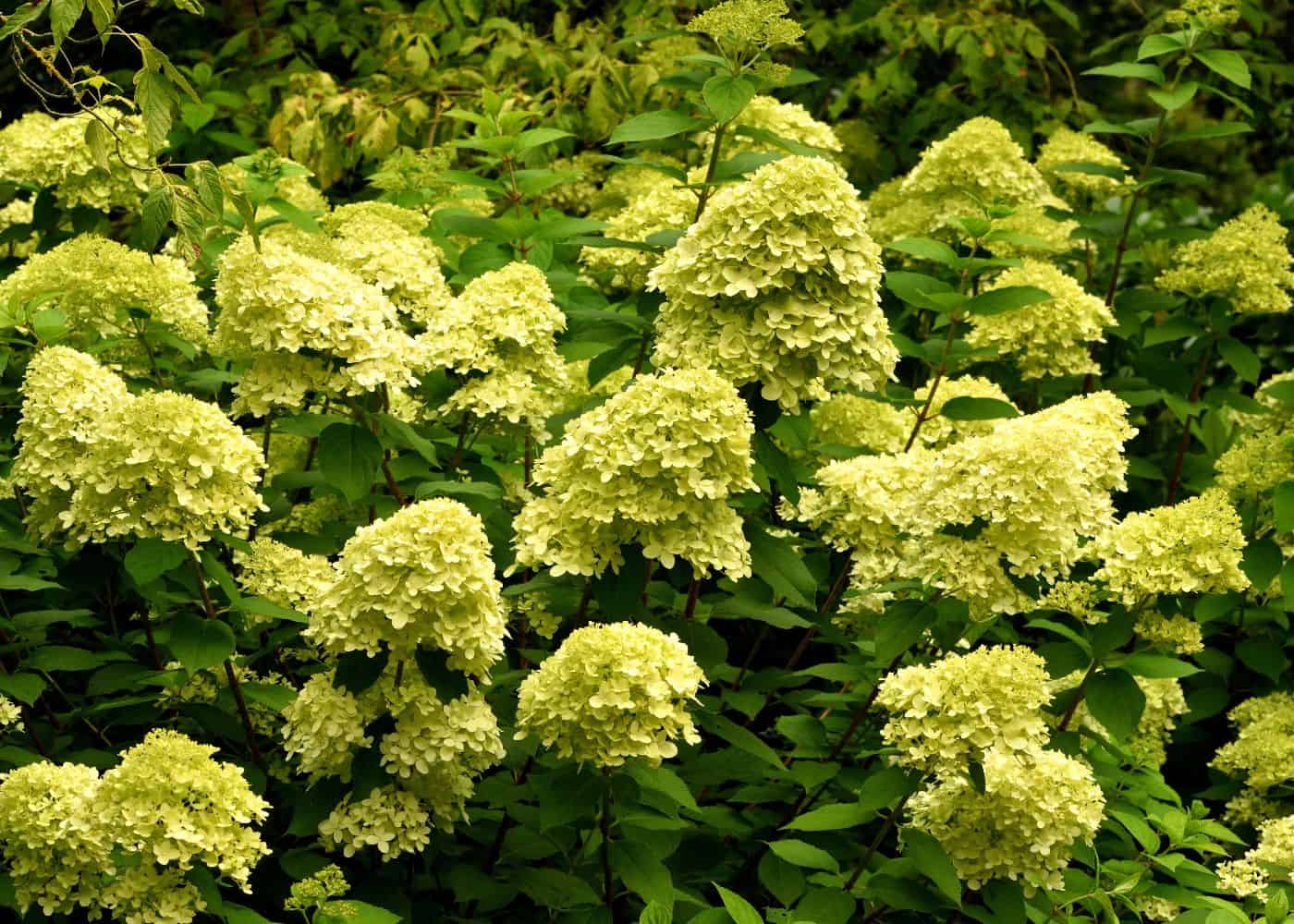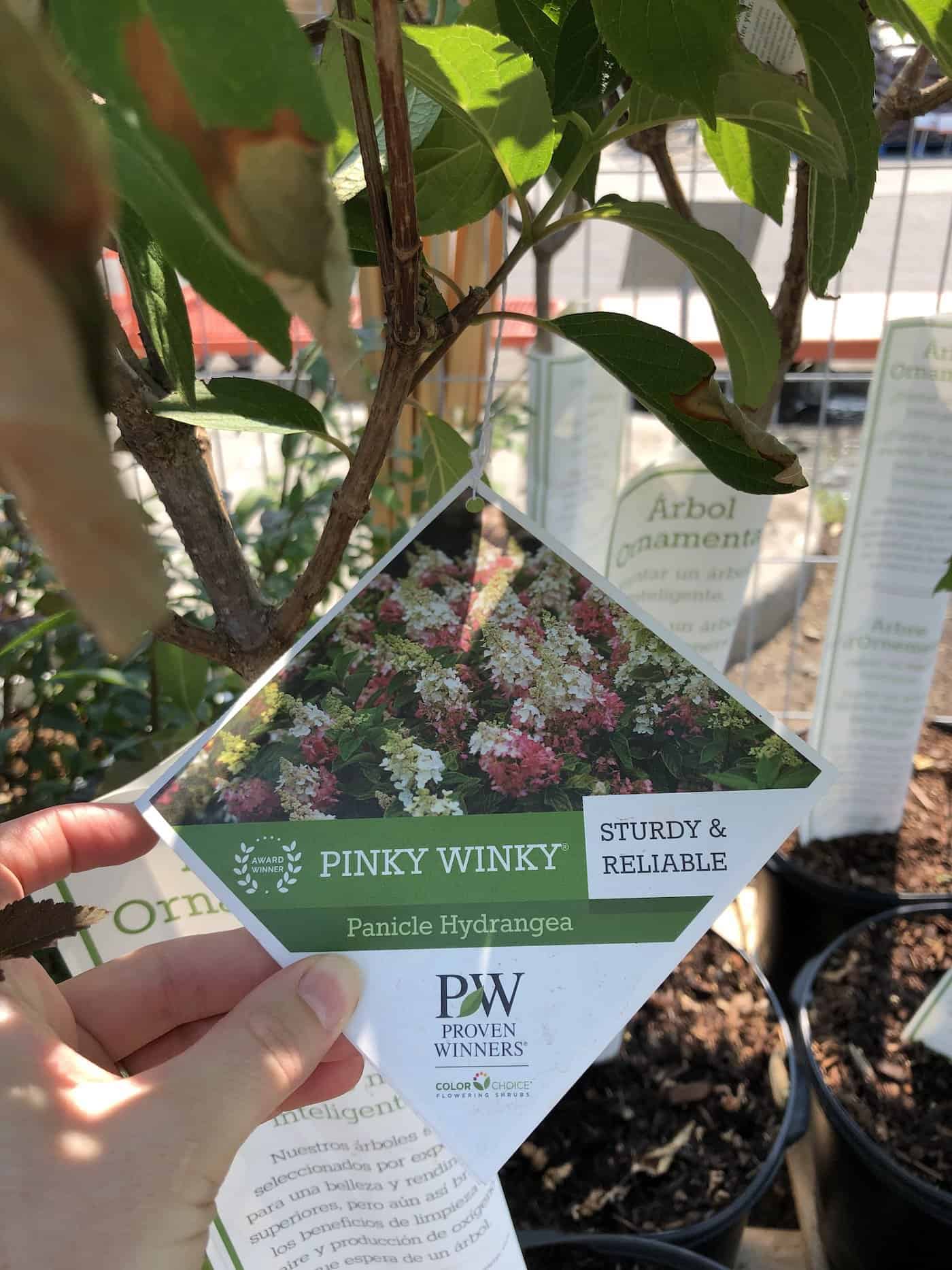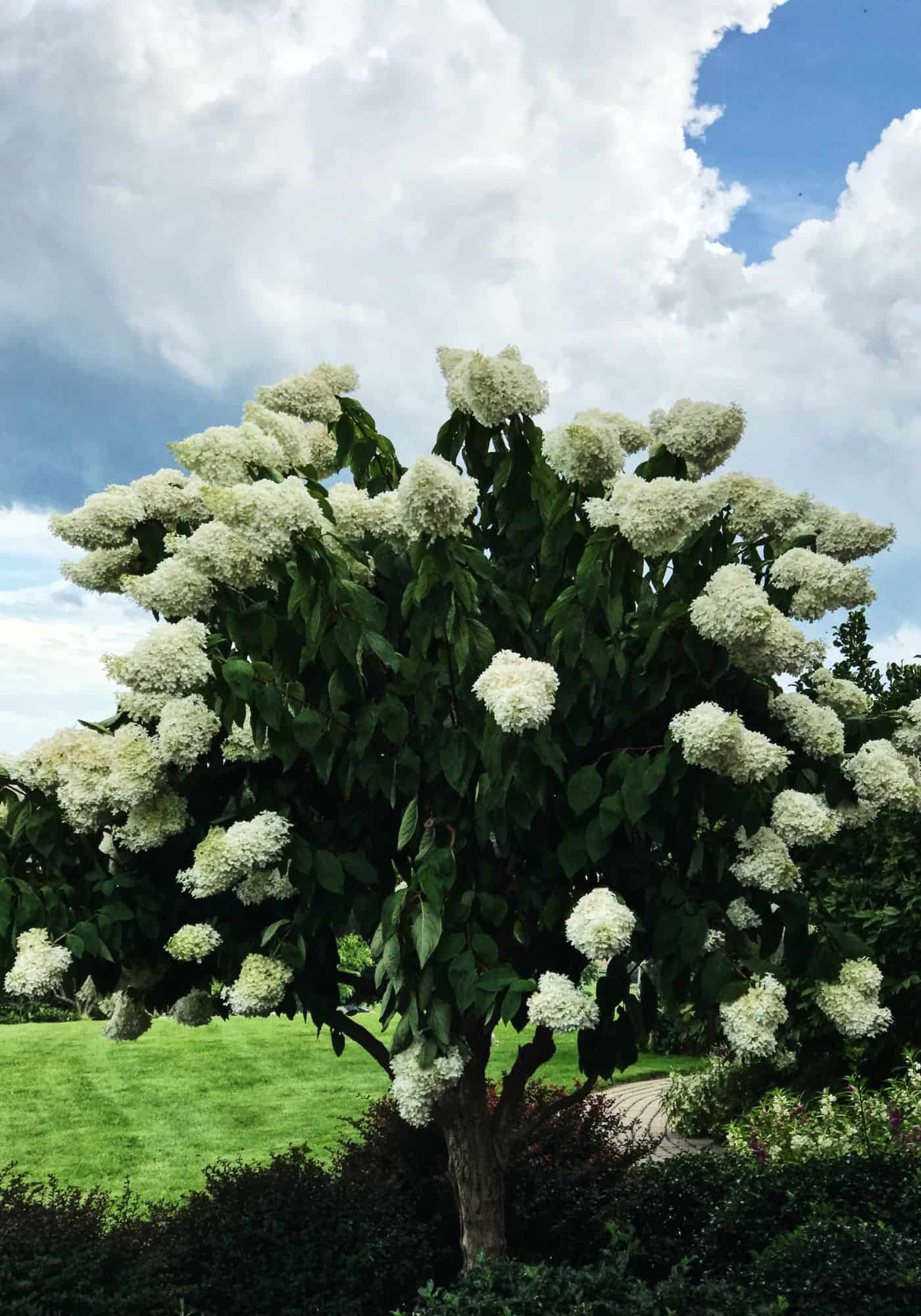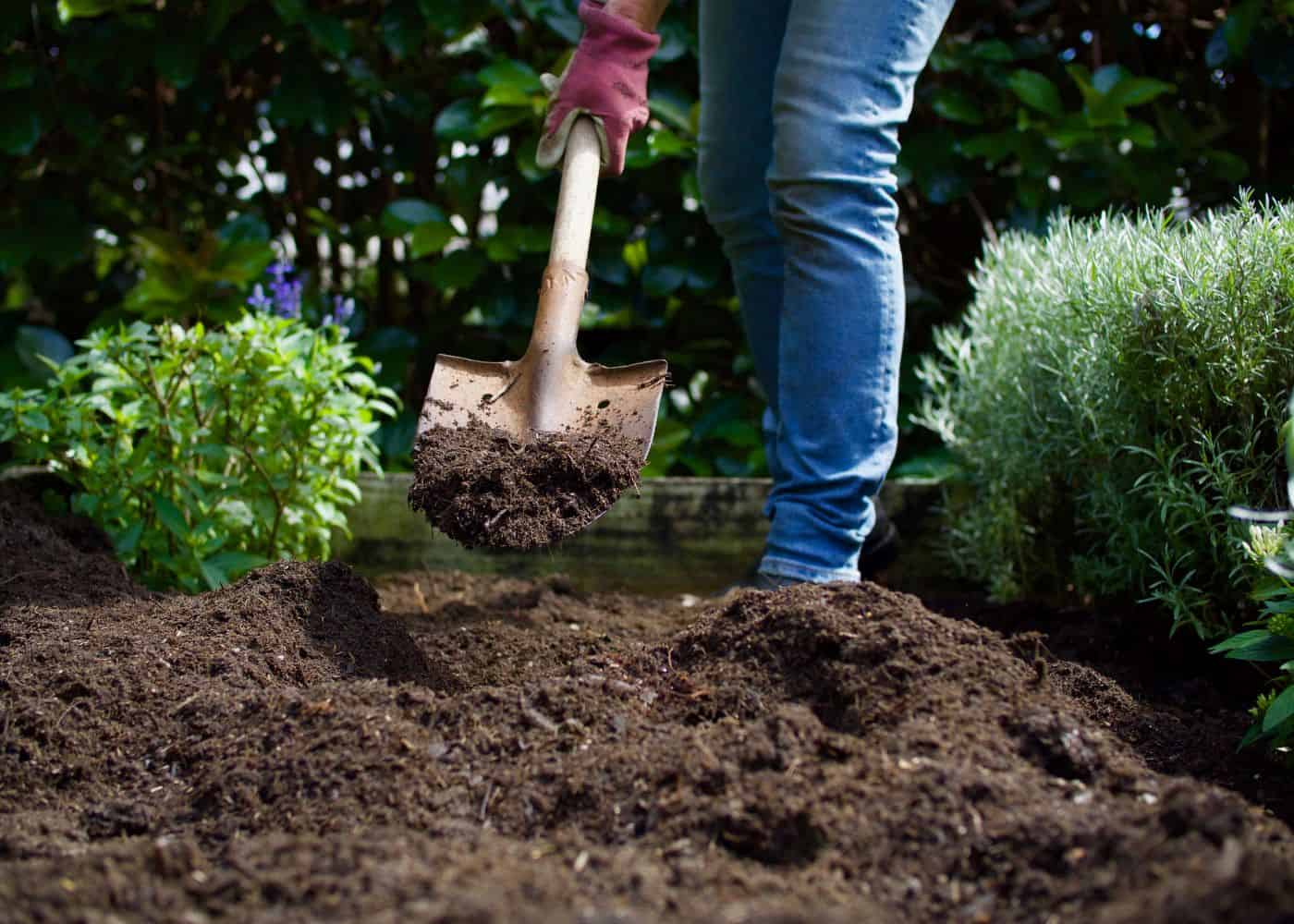To plant a hydrangea tree, start by finding a planting location that receives the right amount of sun and ideally has well-drained soil. Dig a wide shallow hole about twice as wide as the planter pot. Gently remove the pot from the root ball. Check for any circling white roots and loosen them away from the root ball. Then place the root ball in the hole and backfill, making sure not to bury the main trunk any deeper than it was in the planter.
You can plant hydrangea trees any time of year as long as the ground is not frozen, but the best time to plant them is during mild weather in the shoulder seasons (spring or fall). Keep the soil moist for 6-8 weeks after planting, and be sure to water very frequently during heat waves and dry spells.

How to plant a hydrangea tree
Here are the basic steps for planting a tree-form hydrangea plant in your garden:
1. Prepare a planting hole: When you’re ready to plant, dig a wide shallow hole about twice as wide as the planter pot and just as deep. This will ensure that the root ball has enough room to spread out in its new home without getting buried too deeply. If you dig the hole too deep, just put some of the soil back on the base to raise the elevation.
2. Loosen the roots: To remove the pot from the root ball, turn it on its side and gently tap the bottom and sides. Slide the root ball out of the pot. Loosen any circling white roots that may be visible at the edge of the root ball. Don’t leave the roots tightly circled, as roots don’t move once they are in the ground. This is the time to unwind the mess and help the roots grow straight out into the surrounding soil. Don’t be afraid to touch the roots!
3. Place the root ball in the planting hole: Gently place the root ball in the hole. Check that the spot where the main stem meets the potting mix is at the same level as the soil surrounding the hole.
4. Backfill: Backfill, making sure not to bury the main trunk any deeper than it was in the planter. When you get to the top of the root ball, use your foot or hands (depending on how much space you have) to gently tamp down the soil.
5. Water: When the hole is filled in, give the plant a thorough soaking of water. This will help settle the soil and eliminate some air pockets around the roots. Top up the soil in the hole if it is now too low.
6. Mulch: You can also add a layer of organic mulch around the base of your hydrangea tree to help retain moisture in the soil and discourage weed growth. Keep the mulch about 6″ away from the base of the trunk.

When to plant a hydrangea tree
The best time to plant a hydrangea tree is during mild weather in spring and fall shoulder seasons. You can plant hydrangea trees any time of year as long as the ground is not frozen, but you want to avoid planting during periods of extreme heat or cold.
Early spring is a great time to plant. The garden centers generally have good stock in the springtime, and there is a nice variety of different cultivars to choose from. Most climates also enjoy a few months of mild weather before summer heat sets in. Try to get your plants in the ground six weeks before really hot weather arrives (if possible).
Summer planting is not optimal, but it is certainly possible. Summer-planted trees are sometimes less healthy after planting; the cause is usually insufficient water. If you must plant a tree in the heat of summer, water the tree very regularly for the first 6-8 weeks.
Fall is a great time to plant hydrangeas. The ground is warm and the roots can grow into the surrounding soil quickly. Heat waves are also less likely once nighttime temperatures start to cool down.
If you plant in the fall, it’s best to do so before the ground freezes. When planting during colder months, make sure to leave enough time for the tree to settle in and become established before winter sets in.
Where to plant a hydrangea tree
Different species of hydrangeas do best in different planting spots. Most hydrangea trees are panicle hydrangeas (Hydrangea paniculata). They are tolerant of full sun and flower best when they receive 6-8 hours of direct sunlight per day.
Here are some of the most common cultivars:
- Limelight hydrangea (Hydrangea paniculata ‘Limelight’)
- Quick Fire hydrangea (Hydrangea paniculata ‘Bulk’)
- PeeGee hydrangea (Hydrangea paniculata ‘Grandiflora’)
- Vanilla Strawberry hydrangea (Hydrangea paniculata ‘Renhy’)
While most tree-form hydrangeas are panicle hydrangeas (Hydrangea paniculata), it is certainly possible to create standard topiaries from other species. Here are all the most common species of hydrangeas and their preferences for soil, sunlight, and water.
- Panicle hydrangeas (Hydrangea paniculata): These prefer full sun or part shade, and they tolerate a wide variety of soil types. When planting panicle hydrangeas, make sure to give them ample water during dry periods.
- Smooth hydrangeas (Hydrangea arborescens): These do best in partial sun or filtered sunlight and moist but well-drained soil. When planting smooth hydrangeas, make sure to give them specific attention during dry periods and provide additional water if needed. Try to plant them in a location shielded from the hot afternoon sun.
- Oakleaf hydrangeas (Hydrangea quercifolia): These prefer partial shade or filtered sunlight and a moist but well-drained soil. When planting oakleaf hydrangeas, make sure to provide adequate water during heat waves and dry spells.
- Mophead hydrangeas (Hydrangea macrophylla): These prefer partial sun or filtered sunlight and a moist but well-drained soil. When planting mophead hydrangeas, make sure to give them special attention during dry periods.
- Mountain hydrangeas (Hydrangea serrata): These hardy plants prefer partial sun or filtered sunlight, and they tolerate a wide variety of soil types. When planting mountain hydrangeas, make sure to provide adequate water during heat waves and dry spells.
- Climbing hydrangeas (Hydrangea anomala subsp. petiolaris): These prefer partial sun or filtered sunlight and moist but well-drained soil. When planting climbing hydrangeas, make sure to give them special attention during dry periods and provide additional water if needed.

Care after planting hydrangea trees
Once your hydrangea tree is planted, give it plenty of water. Ensure the soil is consistently moist for a minimum of 6-8 weeks after planting. The tree has not yet established any feeder roots outside the planting hole and depends on the gardener for water.
Once the tree has been in the ground for several months, you can ease up on the watering frequency and start to let the soil around the base dry out more between waterings. Work towards watering the tree very deeply on an infrequent basis. You’ll still need to water the tree once or twice weekly as its roots get established.
When new growth appears, trim off any dead or damaged branches. As the tree matures, you can prune it lightly to keep a neat shape. Most tree-form hydrangeas are panicle hydrangeas and are best given their annual pruning in early spring each year.
Additionally, adding a layer of organic mulch around the base of your hydrangea tree will help retain moisture in the soil and discourage weed growth. Keep the mulch about 6″ away from the base of the trunk, and make sure to keep it fresh throughout the year.
Good mulches for hydrangea plants
Hydrangeas grow well with composted organic mulch. One of the best mulches to use is composted yard trimmings. You can sometimes get this sort of composted mulch from the local municipality if they have a hot composting program for local yard waste.
FAQs when planting hydrangea trees
How deep should I plant a hydrangea tree?
Ideally, you should plant a hydrangea tree to the same depth it was planted in its container. When planting, make sure that the root flare (where the roots bulge out from the trunk) is just above ground level. This will help prevent trunk rot and encourage strong growth.
Sometimes a hydrangea tree’s root flare gets buried too deep in the nursery. This can happen during repotting or if the potting soil is topped up. If you suspect the root flare has been buried beneath the soil, take a garden hose and gently wash away the soil from the base of the plant. Look for the root flare and position it so that the flare is above the ground. There may be a few thin young roots coming off the trunk above the soil line, which is ok.
What type of soil should I use when planting a hydrangea tree?
Hydrangeas prefer slightly acidic soil with lots of organic matter in it. If you know you’re working with nutrient-poor and/or alkaline soil, it is preferable to amend the soil before you plant (because it’s difficult to do it after!)
When digging the hole for the tree, you can incorporate some compost into the soil over the whole planting area to add fertility and drainage. Go out farther than the mature canopy of the tree is expected to reach. If you want to raise or lower the pH of your soil, test it first and then adjust as needed.







